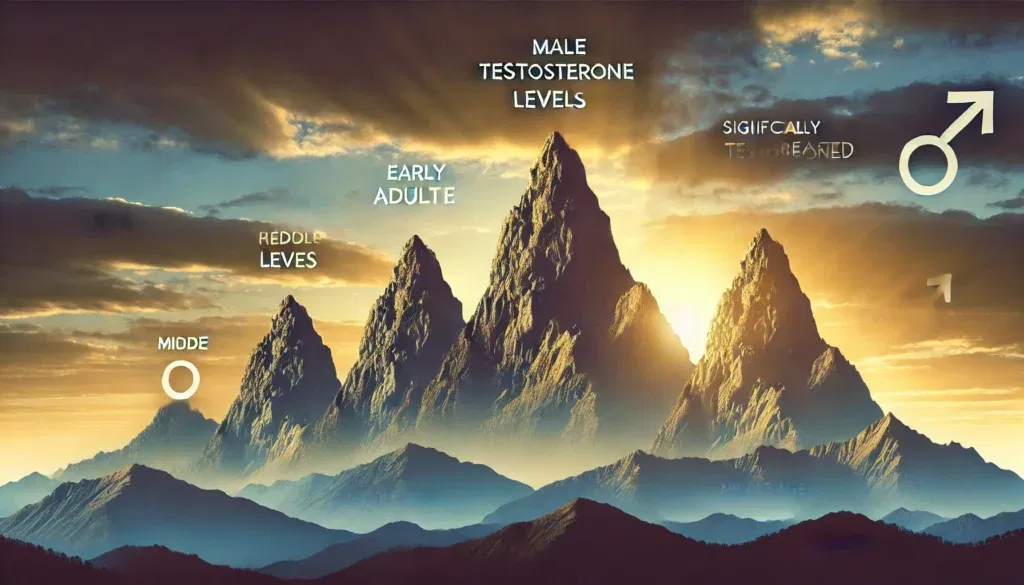Testosterone is one of the most critical hormones for male health, influencing everything from muscle mass and bone density to mood and libido. Understanding male testosterone levels by age is crucial in determining what’s normal, what’s not, and how to check yours. The body’s natural production of testosterone fluctuates throughout life, and while some changes are expected, deviations from the norm can signal underlying health concerns. Whether you’re experiencing symptoms of low testosterone or simply want to optimize your hormone health, understanding the nuances of total and free testosterone levels can provide invaluable insights into your overall well-being.
You may also like: How to Get Your Testosterone Levels Checked: Best At-Home and Lab Testing Options
The Role of Testosterone in Male Health
Testosterone plays a multifaceted role in the male body. As the primary male sex hormone, it is responsible for the development of secondary sexual characteristics during puberty, such as a deepening voice, increased muscle mass, and facial hair growth. However, its influence extends far beyond reproductive health. Testosterone contributes to cognitive function, cardiovascular health, and even metabolic processes like fat distribution and glucose regulation.
Throughout adulthood, maintaining optimal testosterone levels is essential for energy levels, mood stability, and overall vitality. A decline in testosterone production is natural with age, but in some cases, the drop may be more significant, leading to symptoms such as fatigue, decreased libido, depression, and reduced muscle strength. Recognizing when testosterone levels fall outside the normal range can help men take proactive steps toward improving their health.

Testosterone Levels in Men by Age
Testosterone levels are typically measured in nanograms per deciliter (ng/dL) of blood, and these values vary by age. According to research, the average testosterone levels by age are as follows:
- Adolescence (10-19 years): 300-1,200 ng/dL
- Early adulthood (20-29 years): 400-1,000 ng/dL
- Middle adulthood (30-39 years): 300-950 ng/dL
- Late adulthood (40-49 years): 250-900 ng/dL
- Senior years (50+ years): 200-850 ng/dL
While these figures represent general ranges, it is important to understand that individual variations exist. Factors such as genetics, lifestyle, and overall health play a significant role in determining where a man falls within these ranges.
What is Free Testosterone and Why Does It Matter?
Total testosterone refers to the sum of all testosterone in the bloodstream, including both bound and unbound (free) testosterone. However, free testosterone levels are often a more accurate indicator of hormonal health since this fraction of testosterone is biologically active and readily available for the body to use. Normal free testosterone levels in men typically range between 5-25 pg/mL, though this can vary based on age and health status.
Understanding the difference between total testosterone vs free testosterone is crucial, as a man may have normal total testosterone levels but still experience symptoms of low testosterone due to a deficiency in free testosterone. This discrepancy often arises due to high levels of sex hormone-binding globulin (SHBG), which can reduce the availability of free testosterone.
How to Check Your Testosterone Levels
If you are wondering how to check testosterone levels, there are several reliable methods available. A simple blood test is the most common way to measure both total and free testosterone. Tests such as the testosterone total MS (mass spectrometry) test offer highly accurate results by distinguishing between different testosterone molecules in the blood.
When considering where to check your testosterone levels in your bloodwork, look for a comprehensive panel that includes:
- Total testosterone
- Free testosterone
- SHBG levels
- Estradiol levels (as estrogen can impact testosterone balance)
- Luteinizing hormone (LH) and follicle-stimulating hormone (FSH) for insights into pituitary function
These tests provide a more complete picture of your hormonal health, allowing you to assess whether your testosterone levels are within the normal range by age.
Signs of Low and High Testosterone
Testosterone imbalances can manifest in various ways. Low testosterone (hypogonadism) is associated with symptoms such as chronic fatigue, weight gain, reduced libido, erectile dysfunction, depression, and loss of muscle mass. Conversely, high free testosterone levels, though less common, may lead to aggression, acne, excessive hair growth, and even cardiovascular issues.
For men in their 50s wondering, “What is a normal testosterone level for a 50-year-old male?” or “What should my testosterone level be at 50?” the expected range is between 200-850 ng/dL. However, more important than raw numbers is how an individual feels and functions within this range. If symptoms of imbalance arise, further investigation and potential medical intervention may be necessary.
How to Maintain Healthy Testosterone Levels
For those seeking to optimize their testosterone levels naturally, lifestyle changes can make a significant difference. Regular strength training, particularly compound movements like squats and deadlifts, has been shown to boost testosterone production. Additionally, maintaining a balanced diet rich in healthy fats, protein, and essential micronutrients such as zinc and vitamin D can support hormonal health.
Sleep quality is another critical factor, as testosterone production occurs predominantly during deep sleep cycles. Aim for at least seven to nine hours of high-quality rest per night. Managing stress levels through mindfulness practices, exercise, and adequate relaxation also helps regulate cortisol, a hormone that, when elevated, can suppress testosterone production.
Medical Treatments for Low Testosterone
For men with clinically low testosterone levels, medical treatments may be necessary. Testosterone replacement therapy (TRT) is a common option, available in various forms such as injections, gels, and patches. However, it is essential to weigh the potential risks and benefits of TRT, as long-term use may impact natural testosterone production, fertility, and cardiovascular health.
Alternative treatments, including selective estrogen receptor modulators (SERMs) and human chorionic gonadotropin (hCG) therapy, can also be effective in stimulating natural testosterone production without suppressing fertility. Consulting a qualified healthcare provider can help determine the best course of action based on individual needs and medical history.

Frequently Asked Questions (FAQ) on Testosterone Levels
1. How do testosterone levels change with age?
Testosterone levels naturally fluctuate throughout life, peaking during late adolescence and early adulthood before gradually declining. Male testosterone levels by age decrease at an average rate of 1% per year after 30. The testosterone range by age varies significantly, influenced by genetics, lifestyle, and overall health. Understanding the normal testosterone levels by age can help men assess whether their levels are declining at a typical rate or if medical intervention is needed. Maintaining a healthy lifestyle, including strength training and adequate sleep, can help slow down testosterone decline.
2. How can you check your testosterone levels accurately?
To determine testosterone levels in men by age, a blood test is required. The most common method for how to check testosterone levels is through a total testosterone test, which measures both bound and free testosterone. Free test level is the active form of testosterone that affects bodily functions directly. To get the most accurate measurement, blood should be drawn in the morning when testosterone levels are at their highest. Consulting a healthcare professional is essential for understanding results and determining if further testing, such as a testosterone total MS test, is needed.
3. What is the difference between total testosterone vs free testosterone?
Total testosterone includes all forms of testosterone in the bloodstream—both the portion bound to proteins and the free testosterone vs total testosterone that is unbound and readily available for the body to use. Free testosterone, though a smaller fraction, is the biologically active component that influences energy levels, muscle growth, and mood. A normal free testosterone level ensures optimal bodily function, while a high free testosterone level may indicate an underlying condition. Understanding these differences helps in accurately assessing testosterone levels and determining whether intervention is necessary.
4. What should my testosterone level be at 50?
For men in their 50s, testosterone levels continue to decline, with the normal testosterone levels by age chart indicating a range of approximately 300–600 ng/dL. What is a normal testosterone level for a 50-year-old male depends on individual factors such as genetics, fitness level, and overall health. If levels drop too low, symptoms like fatigue, decreased muscle mass, and mood changes may occur. Monitoring testosterone levels by age and seeking medical advice for significant deviations is essential for maintaining health. Lifestyle changes, such as resistance training and balanced nutrition, can support testosterone production.
5. How much more testosterone do males have compared to females?
Males generally have 10 to 20 times more testosterone than females, which accounts for the significant differences in muscle mass, strength, and fat distribution. The testosterone levels by age chart for females shows that while women do produce testosterone, it plays a different role in their bodies, primarily contributing to bone density, muscle tone, and libido. While male testosterone levels by age decrease gradually, women may experience fluctuations due to menstrual cycles, pregnancy, or menopause. Understanding these differences helps in assessing hormonal balance and potential health concerns in both genders.
6. When is testosterone highest during the day?
Testosterone levels follow a diurnal rhythm, peaking in the early morning and declining throughout the day. For men, the best time for how to measure testosterone is between 7 a.m. and 10 a.m., when levels are at their highest. This pattern is why morning blood draws are recommended for the most accurate assessment of testosterone range by age. Factors such as sleep quality, stress, and overall health can affect daily testosterone fluctuations. Maintaining a consistent sleep schedule can help support healthy testosterone production.
7. What does free testosterone mean and why is it important?
Free testosterone is the unbound form of testosterone that is readily available for the body to use. Unlike total testosterone, which includes protein-bound hormones, free testosterone directly impacts muscle growth, libido, and cognitive function. Normal free testosterone levels ensure optimal performance in physical and mental health. Low free testosterone can lead to symptoms like brain fog, reduced strength, and increased body fat. Measuring free testosterone provides a clearer picture of hormonal health compared to just assessing total testosterone.
8. How can you naturally boost testosterone levels?
Improving testosterone levels involves lifestyle modifications such as regular strength training, adequate sleep, and a diet rich in healthy fats and proteins. Resistance exercises, particularly compound movements like squats and deadlifts, are effective for increasing free testosterone vs total testosterone levels. Reducing stress is also critical, as chronic cortisol elevation can suppress testosterone production. Optimizing vitamin D levels and maintaining a healthy weight further support hormonal balance. These strategies help maintain testosterone levels in men by age and slow down natural declines.
9. Where is my testosterone in my bloodwork?
When reviewing bloodwork, testosterone levels are typically found under sections labeled “Total Testosterone,” “Free Testosterone,” or “Testosterone Total MS.” Knowing how to check test levels involves interpreting these values based on age and health status. Average testosterone levels by age help determine whether your levels are within a normal range or require medical attention. If levels are lower than expected, a healthcare provider may conduct further tests to evaluate hormonal imbalances. Understanding these values helps in making informed decisions about testosterone health.
10. What qualifies as top 1 percent testosterone levels?
The top 1 percent testosterone levels are generally well above the standard reference range, often exceeding 1,100 ng/dL. An 1100 testosterone level is rare and usually seen in elite athletes, individuals with exceptional genetics, or those undergoing hormone therapy. However, excessively high levels can pose health risks, including cardiovascular issues and prostate concerns. While maintaining a healthy testosterone level is beneficial, extreme levels should be monitored carefully. Achieving optimal levels through natural means is preferable over artificial enhancement methods.

Conclusion: Taking Control of Your Hormonal Health
Understanding male testosterone levels by age and knowing how to check test levels is essential for maintaining optimal health and well-being. While fluctuations are natural, recognizing when levels fall outside the normal range can help prevent unwanted symptoms and long-term health complications. By adopting a proactive approach to hormone health through lifestyle modifications and medical intervention when necessary, men can ensure they maintain vitality, strength, and overall well-being throughout their lives. If you are experiencing symptoms of hormonal imbalance, seeking professional guidance and comprehensive testing is the first step in regaining control over your health.
testosterone deficiency symptoms, healthy hormone levels in men, ways to check testosterone, best testosterone test kits, hormone balance in aging men, increasing free testosterone naturally, benefits of normal testosterone, effects of testosterone decline, lifestyle changes for testosterone, TRT risks and benefits, supplements for testosterone health, what impacts testosterone levels, hormone optimization in men, strength training and testosterone, best diet for testosterone, role of sleep in testosterone, cortisol and testosterone, maintaining testosterone after 40, testosterone and mental health, signs of hormone imbalance in men
Further Reading:
Standard cutoff point for low testosterone levels may not be accurate for young men
Disclaimer: The information provided in this article is for general informational purposes only. The content does not constitute professional advice of any kind, including but not limited to medical, legal, or financial advice. HisHealthMag and its contributors make no representations or warranties regarding the accuracy, completeness, or reliability of the information presented. Always seek the advice of a qualified professional for any specific concerns or questions you may have. Neither HisHealthMag nor its authors assume any responsibility or liability for any actions taken based on the information provided in this article. The views and opinions expressed are those of the author(s) and do not necessarily reflect the official policy or position of HisHealthMag.





